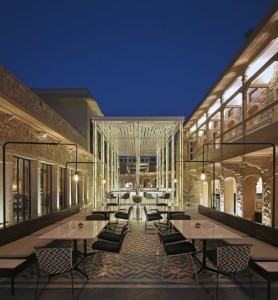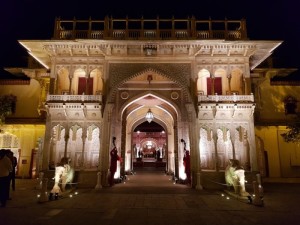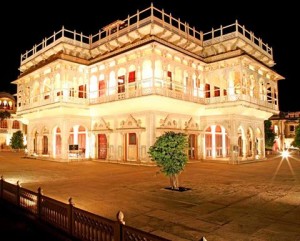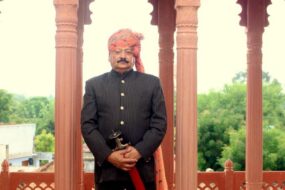The City Palace, Jaipur
The City Palace in Jaipur is spread out over a series of courtyards. It was founded in 1727 by Maharaja Sawai Jai Singh II as part of his ambitious city project, and his successors continued to ornament and add to the elegant buildings up until the 20th century. The palace has always been much more than the grand residence of a royal family. It was also, from the start, a center of patronage of the arts and of learning, and with its many temples, it is also a place of ritual and worship. On important festival days such as Gangaur and Teej, the procession of the image of the Goddess through the streets unites the City Palace and the people of the city in shared celebrations. Today, the palace has thrown open its exclusive spaces to the public through the Maharaja Sawai Man Singh II Museum Trust, welcoming domestic and international visitors from far and wide.
The Maharaja Sawai Man Singh II Museum Trust is responsible for one of the premier palace museums in India, with buildings and collections of national importance, collected and commissioned over the centuries by the Kachhwaha rulers of Amber and Jaipur.
The Museum began during the reign of Maharaja Sawai Man Singh II in 1952 when the Silehkhana and an Art Gallery were opened to the public. At that time, a turban or pagri was a part of the entrance requirement for male visitors, as wearing one was the contemporary etiquette of the Palace. In 1959, a Textile and Costume gallery was added (in the Mubarak Mahal), and the Museum was formally named the Maharaja of Jaipur Museum. In 1972, after the death of Maharaja Sawai Man Singh II, his son and successor Brigadier Maharaja Sawai Bhawani Singh reorganized the museum to expand the collections and buildings and renamed both the Museum and its managing Trust in honor of his father.
Mubarak Mahal
Maharaja Sawai Madho Singh II commissioned the striking Mubarak Mahal, for use as a guesthouse to receive foreign visitors around 1900. As it was situated in the outermost courtyard of the palace, it allowed him to be a gracious host while maintaining his, and his family’s privacy.
Textile Gallery
Under the royal patronage, wondrous textiles and fabrics flourished. These are usually part of the personal collection and being relatively fragile, do not last long. Which is where the Jaipur City Palace is special – it has the largest group of historic royal textiles surviving in India today. This includes all textiles bought for or collected and used by the men and women of the royal family, irrespective of where they were made.
The Painting and Photography Gallery was added in 2015. There is a broad selection of pictures from the Museum’s reserve collections that have been displayed for the first time.Many new and interesting stories about the paintings have emerged as a result.The exhibition begins in the era of the founder, Maharaja Sawai Jai Singh II, in the 18th century and concludes after Indian independence in 1947, when ruler of the time, Maharaja Sawai Man Singh II, was no longer the sovereign ruler of Jaipur, but the democratically appointed symbolic head or Rajpramukh of the Indian state of Rajasthan.This room contains paintings bought for and commissioned by the founder and his sons.
Sarvato Bhadra
The Sarvato Bhadra (where the famous silver urns are displayed) is built on a plinth or platform, with marble pillars that hold up the roof. Sarvato Bhadra means single-storeyed, square, open hall, with enclosed rooms at the four corners. The rest of this building and the courtyard around it is built with ordinary stone pieces, finished smoothly with plaster and then painted pink. One use of the Sarvato Bhadra was as the Divan-e-Khas, or the Hall of Private Audience, which meant the ruler, could hold court with the officials and nobles of the kingdom in a more private, intimate space than the grand spaces of the Sabha Niwas which was open to more people. But it’s also one of the most important ritual buildings in the complex, and continues to be so today, representing ‘living heritage’.
Pritam Niwas Chowk
The gate on the western side of the Sarvato Bhadra courtyard is called Riddhi-Siddhi Pol. Unlike most of the other gates, which are only plastered and painted, this gate is decorated with beautifully carved marble, giving us a hint about its importance – it was used by the Maharajas to enter their private residence! It leads into the Pritam Niwas Chowk, with the 7-storey Chandra Mahal on the right.
The courtyard is rectangular and has the famous painted and carved gateways. All four arched and painted gateways carry pictures of dancing peacocks and blossoming lotus flowers. They were built by Maharaja Sawai Pratap Singh, who lived about 200 years ago. This is the same Maharaja who built the Hawa Mahal. The courtyard was used for the Maharajas’ private gatherings and events, and the women could look down on them the same way they looked at functions in the Sabha Niwas.



Museum at Night with Sculpture Lumiére Show
The Maharaja Sawai Man Singh II Museum Trust, under the patronage of the Royal Family of Jaipur, introduced new evening opening hours, with special tickets for visiting the City Palace Museum and for the first time in India, a Sculpture Lumière Show.
The Museum at Night offers an exclusive experience of the City Palace. The buildings are specially lit and magically transformed, and selected galleries are open for viewing. The highlight of the experience is the Sculpture Lumière, a spectacle of light and music (the state anthem which has been revived by the royal family of Jaipur and re-recorded by Rajasthan Roots). The show is both an art experience and informative: it covers the history of Jaipur and its rulers, using images from the Museum collection, video, and graphics, all projected onto the walls of the Sarvato Bhadra Chowk, and the Chandra Mahal. Guests can visit the illuminated palace buildings, courtyards and museum galleries before the Sculpture Lumiére Show.
Baradari Restaurant
The restaurant, Baradari is the latest in a series of initiatives by the Jaipur royal family to improve the visitor experience to the City Palace. Recently renovated by Studio Lotus, one of India’s leading design practices, it wraps around the courtyard of what was once the historic service court of the City Palace. With cooling water cascades and an elegant bar that plays with the traditional form of baradari (a columned, open pavilion), it is the perfect place to conclude a visit to the Museum or to host a meal. It serves sumptuous Indian and international cuisines in elegant surroundings and also runs a Snack Bar for the convenience of visitors who wish to grab a meal on-the-go.
Chandra Mahal
(A part of the Royal Grandeur Tour)
Chandra Mahal or the moon palace was the main residence of the Maharajas of Jaipur. It is seven stories high and was built in just seven years. The state flag of Jaipur called the panch ranga or five-color flutters on the top. You may notice a smaller, quarter flag flying above it. That denotes that the Maharaja is in residence and is connected with the title ‘Sawai’ that is added to the names of the rulers of Jaipur. The founder of Jaipur, Maharaja Jai Singh the second, was honored by the Emperor Aurangzeb with the title of ‘Sawai’ literally meaning ‘one and a quarter’.
The seven-storied building, Chandra Mahal is built with such proportion that one can hardly realize its grand scale without going around its various apartments. The walls of the verandah of Chandra Mahal on the first floor are covered with life-size portraits of Jaipur rulers painted by German Artist A.H. Muller during the reign of Maharaja Sawai Man Singh II. The verandah faces Royal Jai Niwas gardens, Govind Devji temple and the scenic view of the tiger fort on the Aravali Mountains.
The second storey of Chandra Mahal is Sukh Niwas. The gilded room has walls decorated with gold work from over 200 years ago. The room is full of royal memorabilia, including the famous Lalique Peacock table, an incredible piece specially made for the Royal Family of Jaipur by the world renowned artist Marc Lalique.
Chandra Mahal’s third storey, called Rang Mandir is embellished with mirrors on the walls, pillars, and ceilings.
The fourth storey is called Shobha Niwas. Created in the 18th century, it is a room of mirrors embellished with decorations in color and gold.
The fifth storey is the Chhavi Niwas, which is painted with a floral pattern in blue & white to depict the reflection of clouds in the sky.
The Sixth storey of the palace is Sri Niwas, one of the finest examples of Mughal artwork decorated with mirror & gold during the 18th century. The reflections of the intricate glass work in candlelight is a treat to the viewer’s eye.
The top of Chandra Mahal or seventh storey is known as Mukut Mandir. It is the crown of the royal Palace over which the flag of Jaipur flies relentlessly. One can have a panoramic view of the walled city of Jaipur from the Mukut Mandir.



